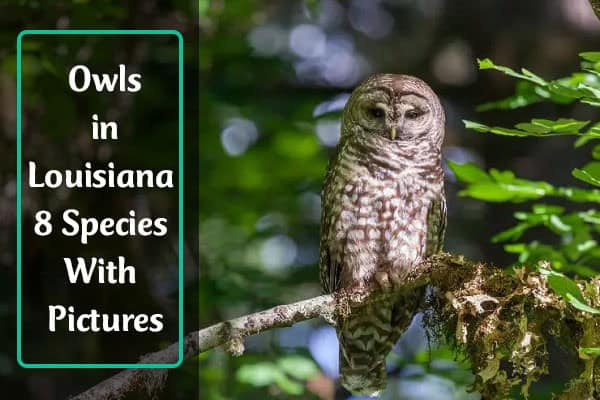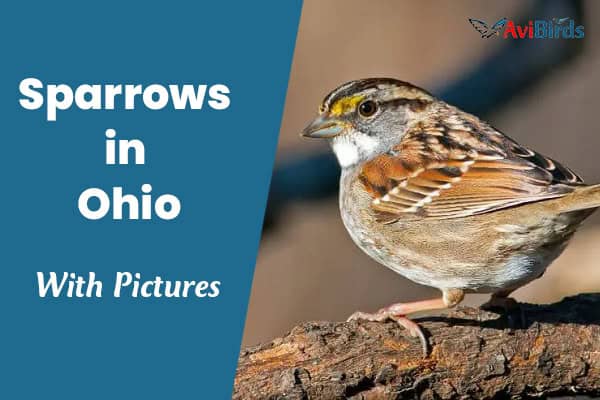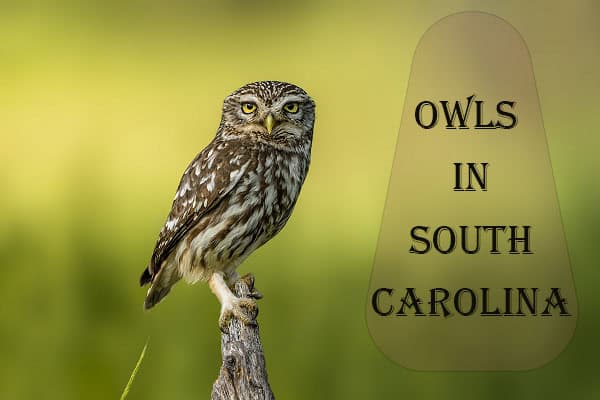Owls in Louisiana (8 Species With Pictures)
Ever thought about the owls living in Louisiana? From the grand Great Horned Owl to the hidden Burrowing Owl, Louisiana is a paradise for owls. But what do we really know about the eight owl types living here? Let’s dive into the world of these night birds and learn about their special traits and habits.
Owls in Louisiana
Louisiana is home to many owl species, each vital to the state’s ecosystem. These birds are fascinating and help control pests, keeping the environment healthy.
Eight owl species call Louisiana home, each with unique traits. The Great Horned Owl is the largest in the Southeast, with a 4.6-foot wingspan. It eats a wide variety of animals, from rodents to skunks and rabbits.
The Barn Owl is another notable species. It lives in many habitats and helps control rodents and invasive Nutria in Louisiana. Nutria can harm swamp habitats.
The Barred Owl is common in Baton Rouge, known for its call. Researchers have released about 50 of these owls, studying their movements and habits.
Other owls in Louisiana include the Eastern Screech-Owl, the Burrowing Owl, the Short-eared Owl, and the Northern Saw-Whet Owl. The Burrowing Owl is becoming more common, especially in Cameron Parish.
Owls in Louisiana are not just interesting to watch. They are crucial for the ecosystem. They control rodents and invasive Nutria, keeping the environment balanced. Protecting these birds is key to preserving Louisiana’s wildlife.
1. Great Horned Owl
- Scientific name: Bubo virginianus
- Length: 18.1-24.8 in
- Weight: 32.1-88.2 oz
- Wingspan: 39.8-57.1 in
- Lifespan: 10-20 years in the wild
In Louisiana, the great horned owl is the largest and most impressive owl. It’s the biggest owl in North America too. With its tufted ears, strong talons, and sharp beak, it’s a top hunter. It can eat small rodents to big animals like jackrabbits and young cats.
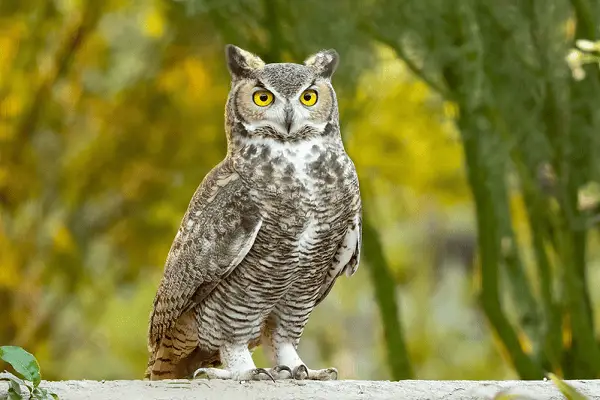
These owls are amazing at living in different places. They can be found in forests and even in cities. They help farmers and homeowners by eating rats.
The great horned owl is known for its size and strength. It can have a wingspan of up to 60 inches and its talons can squeeze with almost 30 pounds of force. They can live up to 13 years in the wild and up to 37 years in captivity.
Its call, a deep “whoo, whoo-whoo, whoo,” is well-known in Louisiana. This call helps them talk to each other and shows they’re important symbols of the state’s wildlife.
The great horned owls in Louisiana are fascinating because of their size, how well they adapt, and their hunting skills. They are a key part of Louisiana’s diverse wildlife. They show the amazing things you can find in the Pelican State.
2. Barn Owl
- Scientific name: Tyto alba
- Length: 12.6-15.8 in
- Weight: 14.1-24.7 oz
- Wingspan: 39.4-49.2 in
- Lifespan: 3-5 years in the wild
The barn owl, known as Tyto alba, is commonly found worldwide. They live in barns and old buildings, unlike other birds that nest in trees. This makes them unique in their choice of home.
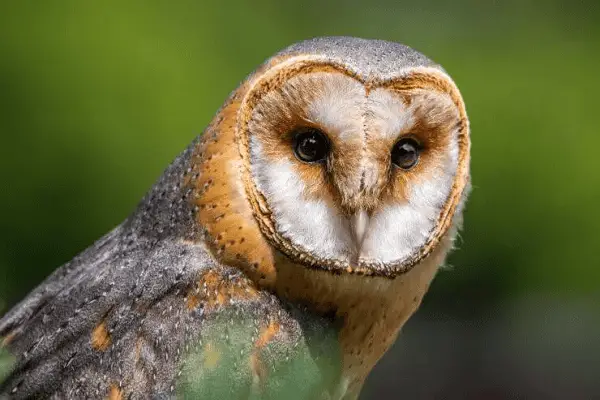
Barn owls migrate to warmer areas for winter, but Louisiana is in their year-round territory. You can see these beautiful birds any time of the year. They live in open areas like fields, where they hunt small mammals like rodents.
| Trait | Measurement |
|---|---|
| Length | 12.6 to 15.8 inches (32-40 cm) |
| Weight | 14.1 to 24.7 ounces (400-700 g) |
| Wingspan | 39.4 to 49.2 inches (100-125 cm) |
Barn owls in Louisiana have special features like heart-shaped faces and sharp hearing. These help them find their barn owl prey in the dark. They are important for keeping rodent populations under control.
“Barn owls are one of the most widespread owls in the world and one of the most widely distributed birds altogether.”
In Louisiana, barn owls live all year, but they’re just one type of owl in the state. Other owls you might see include the Burrowing Owl, Eastern Screech-owl, and more. Each has its own unique traits.
3. Burrowing Owl
- Scientific name: Athene cunicularia
- Length: 7.5-9.8 in
- Weight: 5.3 oz
- Wingspan: 21.6 in
- Lifespan: 6-8 years
The burrowing owl is special in Louisiana. It’s small, about the size of an American Robin. It doesn’t live in trees or fly much. Instead, it runs fast on the ground to catch insects and small mammals.

This owl lives in old burrows made by other animals. It’s found in open areas without many trees. This makes it easy to see in the wild if you’re in its area.
The burrowing owl can make sounds like a rattlesnake to keep predators away. This helps protect its nest at the burrow’s entrance.
The burrowing owl is very rare in Louisiana, especially in the southwest. We need to work hard to save this amazing owl in Louisiana.
4. Eastern Screech-Owl
- Scientific name: Megascops asio
- Length: 6.3-9.8 in (16-25 cm)
- Weight: 4.3-8.6 oz (121-244 g)
- Wingspan: 18.9-24.0 in (48-61 cm)
- Lifespan: 8-10 years in the wild
The eastern screech owl is a standout among Louisiana’s owls. It’s the smallest owl in North America and lives in the state all year. It fits well into many different places.
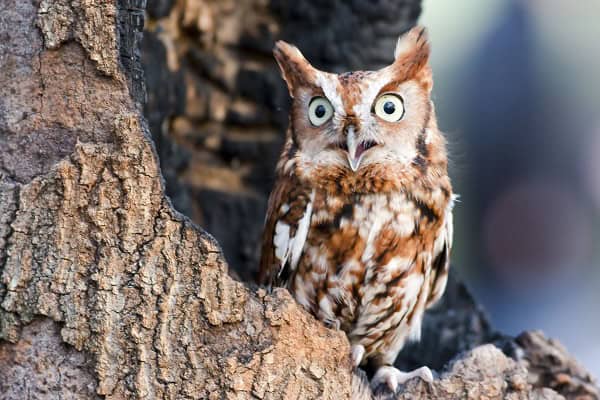
This owl is very flexible and can be found in suburban parks and wooded areas. It eats small rodents, large bugs, lizards, bats, frogs, and crayfish. It has two main looks – the ‘red morph’ and the ‘gray morph’ – which vary by location.
Even though they sleep during the day, eastern screech owls can be heard at night. Their call sounds like a horse’s whinny. They have sharp claws, great eyesight, and can fly quietly. This helps them hunt and play a big role in nature.
- The smallest owl in North America, measuring 16-25 cm in length and weighing 121-244 g.
- Can live up to 14 years in the wild.
- Breeding season is typically February-March, with females laying 2-7 eggs over the course of a week.
- Young owls leave the nest at around 28 days old.
- Pairs of eastern screech owls are monogamous and remain together for life.
If you love birdwatching, nature, or just enjoy Louisiana’s wildlife, the eastern screech owl is a must-see. Its ability to adapt, varied diet, and unique looks make it a gem among Louisiana’s birds.
5. Northern Saw-Whet Owl
- Scientific name: Aegolius acadicus
- Length: 7.1-8.3 in
- Weight: 2.3-5.3 oz
- Wingspan: 16.5-18.9 in
- Lifespan: 5-7 years
The northern saw-whet owl is not as common in Louisiana as some other owls. Yet, these birds sometimes show up in the state. They are small, fascinating owls with unique looks and behaviors.
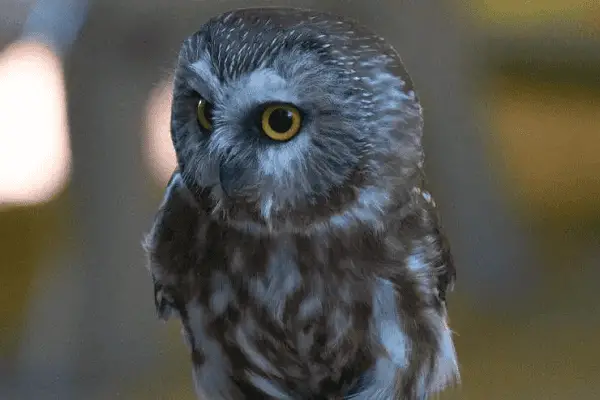
This owl is smaller than a hairy woodpecker but bigger than an eastern screech-owl. It has a big head without ear tufts and mottled brown feathers. Its face and head have a whitish disk and white spots, and its bright yellow eyes make it look almost like a cat.
Northern saw-whet owls don’t swallow their prey whole like many other owls. They tear their food into smaller bits. Their high-pitched calls are unique and help them stand out among Louisiana’s birds.
These owls live mainly in northern forests but can also be found in open areas with good nesting spots. In winter, they might move south, sometimes showing up in city parks or urban areas.
In Louisiana, the northern saw-whet owl is quite rare, with only a few sightings over the years. However recent studies in states like Arkansas have given us new insights into their migration and numbers. As people in Louisiana keep exploring and watching the birds, we might see more of these owls.
Read Our Previous Articles:
6. Barred Owl
- Scientific name: Strix varia
- Length: 16.9-19.7 in
- Weight: 16.6-37.0 oz
- Wingspan: 39.0-43.3 in
- Lifespan: On average, 8-10 years
The barred owl is a stunning large owl found often in Louisiana. It thrives in the state’s old-growth forests and swamps. Known for their “who-cooks-for-you, who-cooks-for-you-all” call, these owls are a favorite among birdwatchers and nature lovers.
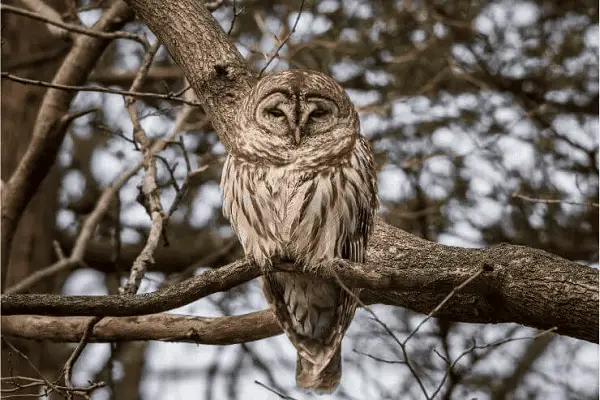
Barred owls are smaller than great horned owls but are friendly. Yet, they protect their territory fiercely. In the south, they are darker and smaller than those in the north.
- Barred owls are the most abundant species of owls found in Baton Rouge.
- Barred owls are one of the most common raptors in Louisiana.
- Barred owls have a very small home range and don’t travel very far.
- One particular barred owl observed had two “home ranges”, an atypical behavior.
Barred owls are successful in Louisiana because they can live in many types of woods. If you’re in the cypress swamps or pine forests, look out for this amazing bird.
“Barred owls are a true marvel of nature, and their frequent sightings in Louisiana are a testament to the state’s rich and diverse ecosystems.”
The barred owl is crucial to Louisiana’s ecosystem. They hunt small mammals, birds, reptiles, amphibians, and invertebrates. Their hunting helps keep the ecosystem balanced, making them important to Louisiana’s nature.
Other Owl Species in Louisiana
Louisiana is home to many owl species, including the Great Horned Owl, Barn Owl, and Burrowing Owl. The Eastern screech owl, Northern Saw-Whet Owl, and Barred Owl are also common. The Long-Eared Owl and the Short-Eared Owl are two more species found in the state.
The Long-Eared Owl looks always surprised and is more social than other owls. It has a wingspan of 35.4 to 39.4 inches. Despite being listed as Least Concern, its numbers are dropping in some places. This shows why owl conservation efforts in Louisiana are crucial.
The Short-Eared Owl likes fields and marshes, making Louisiana a good place for it. These owls can lay up to seven eggs, more if they find plenty of food. Like the Long-Eared Owl, they are also Least Concern but their numbers are falling in some areas. This highlights the need for long-eared owl louisiana and short-eared owl louisiana conservation.
Wrapping Up…
Owls are key to Louisiana’s ecosystems, keeping rodent numbers down and controlling invasive Nutria. While spotting them can be tough, there are ways to boost your chances. State parks and guided tours are great for seeing owls in their natural settings.
Learning about Louisiana’s eight owl species makes you a better birdwatcher. From the common Barred Owl to the unique Eastern screech owl, these birds are vital to Louisiana’s wildlife. With an eye for detail and patience, you can enjoy watching owls in their Louisiana homes.
This guide has shared tips on where to see owls in Louisiana and how to spot them. Supporting Louisiana owl conservation helps ensure these amazing birds stay around for future generations.

